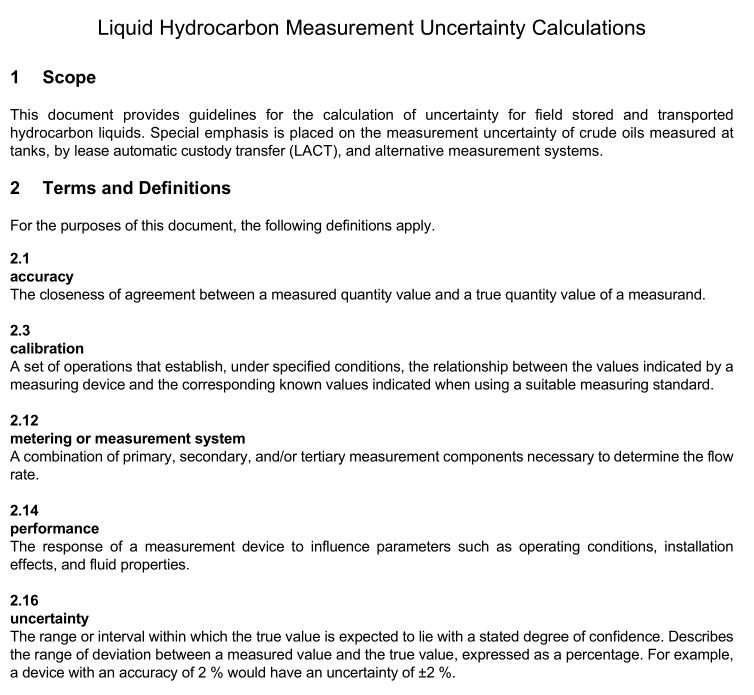API TR 2579 pdf download

API TR 2579 pdf download Liquid Hydrocarbon Measurement Uncertainty Calculations
1 scope
This document provides guidelines for the calculation of uncertainty for field stored and transportedhydrocarbon liquids.Special emphasis is placed on the measurement uncertainty of crude oils measured attanks, by lease automatic custody transfer(LACT), and alternative measurement systems.
2 Terms and Definitions
For the purposes of this document, the following definitions apply.2.1
accuracy
The closeness of agreement between a measured quantity value and a true quantity value of a measurand.
2.3
calibration
A set of operations that establish, under specified conditions, the relationship between the values indicated by ameasuring device and the corresponding known values indicated when using a suitable measuring standard.
2.12
metering or measurement system
A combination of primary, secondary, and/or tertiary measurement components necessary to determine the flowrate.
2.14
performance
The response of a measurement device to influence parameters such as operating conditions,installationeffects, and fluid properties.
2.16
uncertainty
The range or interval within which the true value is expected to lie with a stated degree of confidence.Describesthe range of deviation between a measured value and the true value, expressed as a percentage.For example,a device with an accuracy of 2 % would have an uncertainty of +2 %.
3 Performance Characteristics and Measurement by Meter Type3.1General
The primary purpose of a liquid hydrocarbon meter for any application is to measure the flow.The uncertainty ofmeasurement depends on the measurement equipment selected for the application, proper installation of theequipment, the ability to inspect, verify, or calibrate the various measurement system components, and thefrequency of those maintenance activities. The performance of the meter may also depend on the pipingconfiguration and compensation for variability of operating pressure,temperature, and fluid composition. lt isimportant to recognize individual influence parameters and their effect on the measurement. Since the principleof operation and differing influence parameters have varying degrees of influence by meter type, it is importantto identify and define the significant influence factors for the meter to determine the iotal or combinedmeasurement uncertainty.
3.2Uncertainty Requirements3.2.1General
The purpose of this document is to develop the uncertainty representations and example calculations for meters,provers, and associated equipment used on any metering system such as LACT systems, which can be used toaddress uncertainty requirements.Focus is placed on Coriolis and positive displacement meters since they arethe most commonly used on LACT systems to measure crude oil quantities. With the proper understanding ofindividual system component uncertainties, the overall system uncertainty can be calculated for meteringsystems in the design phase or already in operation in the field.
Specifics of Requirements
The sources of uncertainty that are addressed arise from the following.
— Meter measurement:
— linearity;
— thermal and pressure variation;
— deviation from meter factor proving conditions.
— Fluid properties:
— thermal, pressure, and viscosity variation;
— profile deviation impact.
— Prover:
— temperature, pressure variation.
— Associated devices:
— sediment and water, density.
— Calibration:
— temperature, pressure, density, viscosity, sediment and water.
4 Uncertainty Development
4.1 General
The work by Dahl et al. (2003)
[9] was used as basis for the development of this document. Refer to Annex A
for examples of the uncertainty calculation procedure.
4.2 Basic Equations
The work by Dahl et al. (2003) [9] was used as basis for the development of this document. Refer to Annex A for examples of the uncertainty calculation procedure. 4.2 Basic Equations General NOTE The basic equations developed in the handbook by Dahl et al. (2003) [9] follow the development from ISO 5168:1978 [7] and ISO/IEC Guide 98-3 [8] .
where the term on the left-hand side is the square of the overall uncertainty in the metering system in percent; the right-hand side consists of the squares of uncertainty contributions from (in order): oil and steel expansion, calibration, prover, meter, sediment and water determination, and flow; 푣 ? is intended to signify the measurement by the primary flow meter after corrections from the proving and calibrations have been applied.









